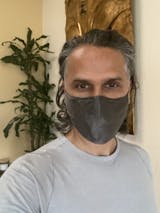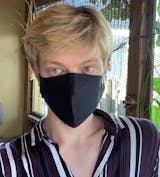Beauty products in 2021 are all about ingredients. Are they sustainably sourced? Are they cruelty-free? Are the ingredients “clean” and non-toxic? Do they actually work?
If history has taught us anything, it’s that we should always read the label, and question everything. Just because the FDA has approved something, doesn’t always mean it’s 100% safe. There are many loopholes in the beauty (and all) industries that companies use in order to get a product approved. The FDA cannot close these loopholes, only our government bodies can do this, which is why so many questionable ingredients can make it into our homes.
The issue with the US market is that the regulations are incredibly lax. In Europe, over 1300 chemicals have been banned from cosmetics due to the health risks they can cause. In the US, only eleven chemicals are banned. So it’s imperative that consumers really know what they are exposing themselves to.
In this article, we're going to discuss common ingredients found in your beauty products, the potential risks involved by being exposed to them, and whether they are really needed for the product to work.
You may have heard of a lot of these ingredients, and many brands are reformulating their products to exclude some of these. But there are still too many brands using many of these ingredients in their products.
Let’s dive in.
13 Nasty Ingredients Found in Your Skincare
Parabens
What are they?
Preservatives to stop the growth of fungus, yeast, and bacteria.
Where are they found?
75-90% of beauty products.
What are the exposure risks?
Known carcinogens and hormone disruptors, and can also cause DNA damage.
Are they necessary?
It is necessary to have some form of preventative for bacterial growth in products for the health and safety of consumers.
Are there safer alternatives?
Certain pure essential oils can work effectively in inhibiting the growth of fungus and bacteria.
Polyethylene glycol (PEG) Compounds
What are they?
Thickeners, solvents, softeners, and moisture-carriers.
Where are they found?
Most skincare products, particularly moisturizers and creams.
What are the exposure risks?
It can potentially contain dangerous contaminants ethylene oxide and 1,4-dioxane, known carcinogens and respiratory irritants.
Are they necessary?
For some products to work effectively, an agent that works in this way is sometimes necessary.
Are there safer alternatives?
Vegetable glycerin is an effective and safe alternative.
Sulphates (SLS, SLES)
What are they:?
Detergents or foaming agents.
Where are they found?
In cleansing products, such as shampoos and soaps.
What are the exposure risks?
It can be highly irritating for the skin and lungs.
Are they necessary?
No, and sometimes foaming agents can strip the skin of natural oils so avoiding anything with a foam can often be better for your skin. However, some skincare products work better with a light foaming action.
Are there safer alternatives?
Decyl Glucoside, derived 100% from coconut or cornstarch is a safer alternative.
Butylated Hydroxyanisole (BHA) & Butylated Hydroxytoluene (BHT)
What are they?
Preservatives and synthetic antioxidants.
Where are they found:
In lipsticks, moisturizers, and the food industry.
What are the exposure risks?
They are known skin irritants and possible carcinogens.
Are they necessary?
No. This prolongs the shelf life of products, which means the ingredients of that product are likely not going to be as fresh or clean.
Are there safer alternatives?
If you prefer a longer shelf life, look for ingredients such as Rosemary oil, which is a natural preservative.
P-phenylenediamine (PPD) or Color Index (CI)
What are they?
Chemicals called aromatic amines that turn dark when oxidized.
Where are they found?
In hair dyes for coloring the hair. Also in the plastic and chemical industries as byproducts of manufacturing,
What are the exposure risks?
Dermatitis, eye irritation, asthma, gastritis, renal failure, vertigo, tremors, convulsions.
Are they necessary?
Absolutely not.
Are there safer alternatives?
There are many non-PPD hair dyes available on the market, try Henna Color Lab.
Diethanolamine (DEA)
What is it?
A colorless, viscous liquid used to thicken and create more foam in skincare.
Where is it found?
Shampoos, soaps, bubble baths, etc.
What are the exposure risks?
It is a known irritant to lungs and skin.
Are they necessary?
Thickening a product is sometimes necessary, however this ingredient is not the only option out there for that purpose.
Are there safer alternatives?
Xanthan Gum is a safe natural thickening agent used in the food and beauty industry. Adding more foam to a product can strip the skin of natural oils, so it’s recommended that you avoid additional foaming agents.
Dibutyl Phthalate (DBP)
What is it?
A synthetic-made plasticizer.
Where is it found?
In nail polishes to prevent cracking.
What are the exposure risks?
Hormonal disruption and developmental defects in fetuses, as well as liver and kidney failure.
Are they necessary?
Something is needed to prevent cracking and chipping in nail polish, but there are alternatives.
Are there safer alternatives?
Brands like Kapanui Nails is a vegan, toxic-free nail polish and nail care brand from Hawaii. There are only 3 ingredients in their nail polish: water, acrylates emulsion(a non-toxic formulation), and mineral pigments.
Formaldehyde-releasing ingredients
What are they?
Ingredients such as DMDM hydantoin, diazolidinyl urea, imidazolidinyl urea, methenamine, quaternium-15, and sodium hydroxymethylglycinate, preservatives used to prolong the shelf life of a product.
Where are they found?
Hair care, cosmetics, and anything with a shelf life.
What are the exposure risks?
These are known carcinogens.
Are they necessary?
No. As mentioned above, preservatives are a way to prolong a product to get the most for their financial investment, but they do nothing for the product, besides make an inferior, unsafe product.
Are there safer alternatives?
Geogard ECT™, which is a formulation of naturally-derived Benzyl Alcohol, Salicylic Acid, Glycerin, and Sorbic Acid.
Fragrance or Parfum
What are they?
They are smell-enhancing formulations, made up of 3000 different ingredients, and due to trademark and patent loopholes, are not required by law to be listed anywhere.
Where are they found:?
In everything from cleansers to lotions.
What are the exposure risks?
As mentioned above, the exact ingredients are not required to be listed, so you just don’t really know what is in them. But they are known to be skin and lung irritants, and possible hormone disruptors, and carcinogenic.
Are they necessary?
No. These have absolutely zero efficacy in skincare, and should be avoided at all costs.
Are there safer alternatives?
Essential oils can be used instead, but some people are also sensitive to those. If possible, going fragrance free is your safest and best option.
Petrolatum
What is it?
It is a mineral oil, extracted from the earth as crude oil, and converted to petrolatum (jelly), used as a barrier to “lock-in” moisture.
Where is it found?
In creams, lotions, moisturizers, and many other products.
What are the exposure risks?
Cancer. Mineral oil is a byproduct of crude oil. Crude oil is highly carcinogenic. While petrolatum has been refined to a point where it is deemed safe by the FDA, there are still some companies that claim petrolatum is not safe.
Are they necessary?
The barrier petrolatum gives products is often an important feature, in things such as moisturizers.
Are there safer alternatives?
Beeswax and Carnauba wax both act as a barrier in skincare, and are 100% natural and safe for use.
Siloxanes
What are they?
Silicone. They are an anti-static, emollient, humectant, solvent, viscosity-controlling and hair conditioning ingredient.
Where are they found?
In many skincare and hair care products.
What are the exposure risks?
It has been found to be toxic, persistent, endocrine disrupting and has links to fertility issues.
Are there safer alternatives?
Bamboo and Daikon Seed extracts are both natural and safe alternatives to silicone.
Triclosan
What is it?
An ingredient used to prevent bacteria contamination.
Where are they found?
In many skincare and cosmetic products, including hand sanitizers and antibacterial soaps.
What are the exposure risks?
Alters hormone regulation in animals. Might contribute to the development of antibiotic-resistant germs. Might be harmful to the immune system.
Are they necessary?
Yes, it is necessary to have a bacteria-inhibitor in some products. But using an unsafe ingredient is not the way to do that.
Are there safer alternatives?
New ingredients have been discovered as a result of triclosan being banned in the UK. Salibact is broad-spectrum, biodegradable, antimicrobial active that is effective against gram positive and gram negative bacteria, fungi, yeast and molds.
Selenium Sulphide
What is it?
An inorganic compound and medication used in the cosmetic and medical industry.
Where are they found?
Usually in anti-dandruff shampoo, and fungicides.
What are the exposure risks?
This is a known carcinogen. Ironically, it’s also linked to hair loss, irritation of the skin, weakness, and feeling tired.
Are they necessary?
Anti-dandruff treatment is necessary for some people, but there are alternatives.
Are there safer alternatives?
Tea tree oil has long been used as a safe and natural anti-dandruff treatment. Coconut oil is another natural ingredient to treat hair dryness and dandruff.
This list is by no means exhaustive. There are hundreds of questionable ingredients in your skincare and cosmetic products that you probably have in your home. Go right now and take a look at your shampoo and conditioner, your cleansers, or your handwash. Are any of the ingredients above listed on the label?
Three Brands That Don't Contain These Ingredients
There are so many amazing brands out there who are doing great by their consumers. They source ethical and sustainable ingredients, that actually work, and that are safe and clean. Here are three of our favorites:
This company has formulated the industry’s first zero-waste makeup palette using sustainable ingredients, and 100% recyclable palettes. They are US-based, but have taken it upon themselves to ban over 1400 ingredients that are controversial, ambiguous, or questionable in any way to ensure that their products are safe and high quality.
This botanical-based brand uses only the finest and most active ingredients found in nature. They source everything from fair trade, organic, and wildcrafted artisans, and are committed to a better world through their philanthropic efforts.
This UK-based company was founded on the belief of giving food and beverage byproducts a second life by formulating them into their skincare. Their ingredients are predominantly natural and organic, and are 100% sustainably sourced.
A great rule of thumb to follow when purchasing products you’re going to be using on yours and your family’s bodies is to choose brands that are known to be sustainably and ethically sourced. Brands that are known for their quality assurance. But if you really don’t know, you can always buy from Fait avec Coeur. We research and vet every single brand that we onboard, so you don’t have to.
Emma Masotti is an Australian now living in Austin, TX, and has been a trained esthetician for over 15 years. She is a sustainable skincare writer, educating and building awareness around proper skin health that doesn’t cost the earth.
Some of the products promoted in our blog are from our online store. Many others are brands we have researched and found to be great examples of sustainable, ethical, and innovative brands in their field, and we don't make any profit from mentioning them in our blog. #CollaborationOverCompetition










